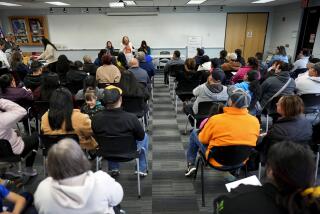Alabama’s immigration law prompts alarm
Alabama’s estimated 130,000 illegal immigrants are worried. They are confused. And in some cases, they have disappeared.
They have disappeared from classrooms and from tomato fields.
Last week, some had disappeared from the Guadalajara Jalisco restaurant, a former diner now serving Tex-Mex fare to a largely American-born clientele in this sleepy town east of Birmingham.
Manager Fredy Vergara had lost three of his 12 employees, and more workers said they planned to leave soon, fleeing in fear of Alabama’s new immigration law.
Waiter Ever Salas struck out for Washington state. Elbia Manzilla, for Texas. A hostess named Joana was a legal resident, but her parents were not, Vergara said. They would probably head out soon for Chicago.
On Wednesday afternoon, the regulars were rolling in for the lunch rush, and Vergara’s staff was making do, serving up enchiladas and chile rellenos, brisk and courteous.
“But all we’re thinking about,” said Vergara, a legal resident from Colombia, “is immigration.”
The bulk of the new immigration law, the nation’s strictest, is now in effect after being upheld Sept. 28 by a federal judge.
Among other things, the law requires police to check the immigration status of suspects and turn illegal immigrants over to federal authorities. It requires school officials to demand birth certificates from students enrolling for the first time, though the schools may not turn students away. It forbids illegal immigrants to engage in business transactions with state government.
On Friday, the Justice Department asked the 11th Circuit Court of Appeals to block the law until the court could consider it fully. Government lawyers argued, as they have about similar legislation in other states, that the law contravenes the federal government’s immigration enforcement function.
So far, the evidence of an Alabama exodus is anecdotal. But proponents are already hailing the law as an example of “attrition through enforcement.”
Others, like Mary Bauer, legal director of the Southern Poverty Law Center, are calling the law a “humanitarian crisis.” She said her anti-discrimination group had set up a hotline after the judge’s ruling and received 2,000 calls from worried families.
Callers were afraid to drive sick relatives to the doctor. Kids at school were being bullied. Municipal water companies were refusing to establish new service for people who couldn’t prove they were legal.
“It is a dark day here in Alabama,” Bauer said.
Some businesses are already feeling the effects. In northeast Alabama, the owners of Smith & Smith Farms were trying to harvest 90 acres of tomatoes with three trucks of workers each day instead of the usual 12.
“We have hired some whites,” said Kathy Smith, wife of co-owner Leroy Smith. “Some of them work out a little bit. Some might work three hours and they quit.”
Jimmy Latham, a Tuscaloosa contractor and president of Alabama Associated General Contractors, said the law would slow down the rebuilding effort underway in the wake of the devastating spring tornadoes.
“We’re seeing smaller crews and seeing work taking longer to accomplish,” he said. The bill’s authors, he said, may have assumed that native Alabamians would take the jobs that Latinos left behind, with state unemployment at 10%.
“That has not been the case so far,” he said.
State officials, meanwhile, have been battling widespread confusion. The state’s homeland security director, Spencer Collier, has begun touring the state to brief law enforcement officers on how to apply the law.
The state education department has sent Spanish-language audio files to radio stations promising listeners that the immigration details they collect will not be passed on to federal officials, but to the Legislature to tabulate how many illegal immigrants were in schools.
It seemed to be working, education spokeswoman Malissa Valdes said: On the Monday after the ruling, 2,285 Latino students, about 6% of the statewide total, stayed home from school. Two days later, the number was back down to 4%, the typical rate of absence.
In Tarrant, a working-class suburb of Birmingham, Latino parents with questions crammed into an information session at an elementary school with children in tow. This small school district was “maybe 1%” Latino a decade ago, Supt. Shelly Mize said. Today it’s closer to 10%.
Monica Hernandez, an organizer with the Southeast Immigrant Rights Network, advised the parents not to open the door for anyone unless the person had a warrant — and to give only their name and address to police until they could obtain the services of a lawyer.
The parents asked about rumors: Could the police nab you just for walking your kids to school?
No, Hernandez told them, the police must be conducting an investigation and must have a “reasonable suspicion” that a person is here illegally.
Is it true they are targeting male drivers, not female? No, she said. And no to many others.
“Fear is normal,” she told them in Spanish. “But the only thing we can do is try to be as strong as possible.”
Afterward, a 30-year-old factory worker also named Monica was one of many who pressed up with more questions. She was a single parent and a homeowner, she said. If she moved, she wondered, what would become of her house?
“I feel so depressed,” she said. “I can’t drive anywhere. I only go to the store. I’m afraid.”
At the Guadalajara Jalisco restaurant, patrons had complicated feelings about the law and the restaurant, which was started by a Mexican businessman about 15 years ago.
Janice and John McLaughlin have been regulars for years. When the place opened, John said, they were thrilled “to have something to eat that wasn’t a burger.”
But Janice said the law was the law: “I basically think that if you’re here illegal, you need to be sent back.”
More to Read
Start your day right
Sign up for Essential California for news, features and recommendations from the L.A. Times and beyond in your inbox six days a week.
You may occasionally receive promotional content from the Los Angeles Times.






